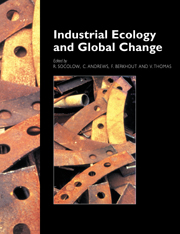Book contents
- Frontmatter
- Contents
- Foreword
- Preface
- Acknowledgments
- Contributors
- OVERVIEW
- PART 1 VULNERABILITY AND ADAPTATION
- PART 2 THE GRAND CYCLES: DISRUPTION AND REPAIR
- 8 Introduction
- 9 Human Impacts on the Carbon and Nitrogen Cycles
- 10 Charting Development Paths: A Multicountry Comparison of Carbon Dioxide Emissions
- 11 Reducing Urban Sources of Methane: An Experiment in Industrial Ecology
- 12 Reducing Carbon Dioxide Emissions in Russia
- 13 Energy Efficiency in China: Past Experience and Future Prospects
- 14 Roles for Biomass Energy in Sustainable Development
- PART 3 TOXICS AND THE ENVIRONMENT
- PART 4 INDUSTRIAL ECOLOGY IN FIRMS
- PART 5 INDUSTRIAL ECOLOGY IN POLICY-MAKING
- END PIECE
- Organizing Committee Members
- Working Groups
- Index
11 - Reducing Urban Sources of Methane: An Experiment in Industrial Ecology
Published online by Cambridge University Press: 04 August 2010
- Frontmatter
- Contents
- Foreword
- Preface
- Acknowledgments
- Contributors
- OVERVIEW
- PART 1 VULNERABILITY AND ADAPTATION
- PART 2 THE GRAND CYCLES: DISRUPTION AND REPAIR
- 8 Introduction
- 9 Human Impacts on the Carbon and Nitrogen Cycles
- 10 Charting Development Paths: A Multicountry Comparison of Carbon Dioxide Emissions
- 11 Reducing Urban Sources of Methane: An Experiment in Industrial Ecology
- 12 Reducing Carbon Dioxide Emissions in Russia
- 13 Energy Efficiency in China: Past Experience and Future Prospects
- 14 Roles for Biomass Energy in Sustainable Development
- PART 3 TOXICS AND THE ENVIRONMENT
- PART 4 INDUSTRIAL ECOLOGY IN FIRMS
- PART 5 INDUSTRIAL ECOLOGY IN POLICY-MAKING
- END PIECE
- Organizing Committee Members
- Working Groups
- Index
Summary
Abstract
Methane is a powerful greenhouse-forcing gas, and its main anthropogenic sources arise from leaks in natural gas distribution networks, landfills, and sewage treatment facilities. A new portable device for detecting and monitoring urban methane fluxes is described. Once detected, leaks can often be cheaply prevented, thus reducing costs and reducing urban carbon emissions. The redesign of cities to optimize industrial and domestic carbon metabolisms is suggested.
Reducing greenhouse gas emissions will be a primary task for the field of industrial ecology. Many nations have agreed to the principle of reducing greenhouse gas emissions, especially carbon dioxide emissions related to fossil fuel combustion. The Convention on Climate Change, endorsed by 153 countries at the U.N. Conference on Environment and Development (UNCED) in June 1992, requires industrial countries to develop national emission limits and emission inventories for greenhouse gases. Although the document signed at UNCED lacks emissions reduction targets and timetables, it embodies the goal of returning greenhouse gas emissions to ‘earlier levels’ by the turn of the century (Parson et al., 1992). Actions pledged by some industrial countries, principally in Western Europe, have called for either a freeze or a 20% reduction in carbon dioxide emissions by the year 2000 or soon thereafter. In February 1991, the U.S. government proposed that a comprehensive framework for greenhouse gases would be preferable to focusing on carbon dioxide. At present, the entire process of reaching an international consensus is bogged down in a mire of disagreements over goals, targets, timetables, and equity issues (e.g., Collins, 1991).
- Type
- Chapter
- Information
- Industrial Ecology and Global Change , pp. 173 - 182Publisher: Cambridge University PressPrint publication year: 1994
- 3
- Cited by



